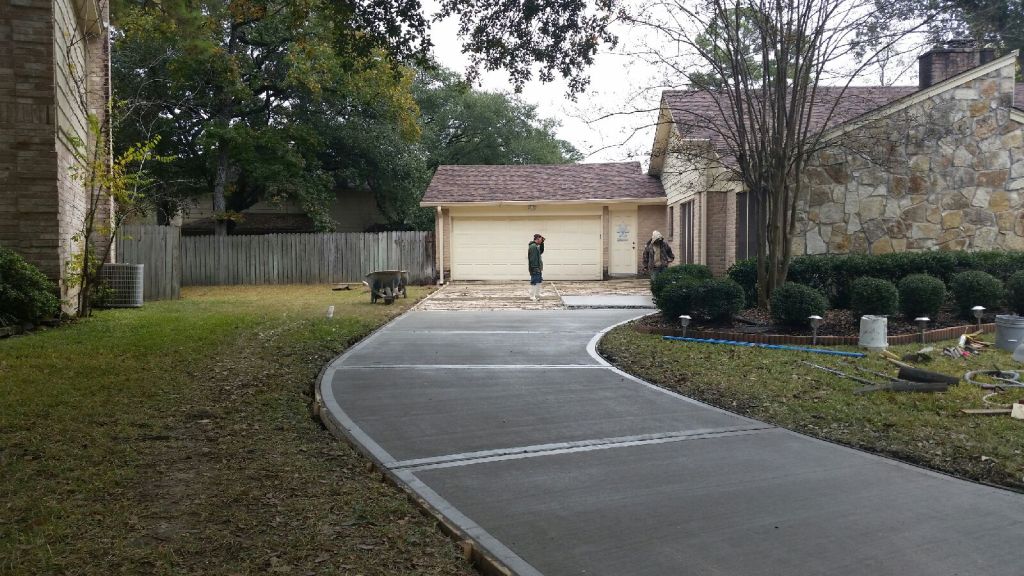Click Here for Specialist Advice on Selecting the Perfect Concrete Contractor
Click Here for Specialist Advice on Selecting the Perfect Concrete Contractor
Blog Article
The Environmentally Friendly Choice: Concrete Sidewalks for Your Community
Concrete sidewalks are a common attribute in most neighborhoods, yet their effect on the environment is frequently neglected. Choosing concrete for your community sidewalks can make a significant distinction in terms of sustainability and eco-friendliness. The advantages of choosing concrete surpass plain visual appeals and functionality. By considering the ecological advantages and long-term impacts on the neighborhood, the choice of products for walkways becomes an essential decision. Allow's check out why concrete sidewalks may be the eco-friendly option your neighborhood requires.
Advantages of Concrete Sidewalks
When thinking about the installation of walkways in a neighborhood, the advantages of choosing concrete over other products are substantial and various. Concrete pathways offer longevity, standing up to hefty foot traffic, weather condition variations, and environmental aspects much better than different materials like asphalt or gravel. This long life translates to cost-effectiveness in the long run, as concrete walkways call for much less frequent repair services and upkeep. Additionally, concrete is a flexible product that can be conveniently customized to match the visual of any kind of neighborhood with numerous finishes, colors, and patterns.

Sturdiness and Longevity
How can concrete sidewalks exceed other products in terms of sturdiness and longevity? Concrete sidewalks are renowned for their phenomenal resilience and long life compared to different products like asphalt or pavers. The intrinsic strength of concrete makes it extremely resistant to splitting, shifting, and general wear and tear triggered by foot traffic, weather condition variations, and various other environmental aspects. Unlike asphalt, which can soften in heats and fracture in freezing problems, concrete keeps its architectural integrity, requiring very little maintenance gradually.
Furthermore, concrete's sturdiness decreases the requirement for regular repair services or substitutes, making it a sustainable and affordable choice for area pathways. By investing in concrete sidewalks, communities can enjoy a dependable and lasting infrastructure that enhances the total visual charm and functionality of the location.
Low Maintenance Needs
Concrete pathways stand out for their minimal upkeep needs due to their resilient nature and resilient efficiency. Unlike alternative materials that might call for frequent repair services or substitutes, concrete sidewalks provide from this source a cost-effective service that demands little maintenance over time.
Regular upkeep for concrete sidewalks commonly involves basic jobs such as regular cleaning to eliminate particles and periodic sealing to safeguard the surface area. In contrast to materials like asphalt or pavers that may change, crack, or deteriorate even more easily, concrete pathways maintain their structural stability with minimal intervention. Additionally, any repair work that might be required are generally localized and can be addressed swiftly, decreasing both the time and cost related to maintenance.

Ecological Benefits
With a focus on sustainability and eco-friendliness, concrete sidewalks offer notable ecological advantages that add to a greener neighborhood framework. Additionally, concrete pathways have a high solar reflectance index, implying they mirror a considerable quantity of sunshine instead of soaking up and keeping warmth.
Furthermore, concrete is a porous material that permits water to penetrate into the ground, decreasing stormwater overflow and aiding in groundwater recharge. This helps prevent disintegration, reduce flooding, and preserve the natural equilibrium of water supply in the neighborhood. By choosing concrete walkways, neighborhoods can make a lasting option that favorably influences the setting Continued and enhances the lifestyle for locals.
Enhancing Community Sustainability
By prioritizing sustainable facilities options, communities can grow an unified equilibrium between environmental consciousness and neighborhood advancement. Enhancing community sustainability includes a diverse method that surpasses just the environmental benefits of concrete sidewalks. Implementing green spaces, promoting energy-efficient practices, and cultivating a feeling of area involvement are essential components of creating a lasting area.
One way to enhance neighborhood sustainability is via the assimilation of absorptive concrete pathways. These walkways permit rainwater to leak right into the ground, lowering stormwater drainage and lessening the stress on community drainage systems. Concrete Contractor. By incorporating absorptive walkways, communities can improve water quality, lower flooding threats, and improve general ecological strength
Moreover, promoting alternative transport methods such as walking and biking can dramatically minimize carbon emissions and advertise a healthier lifestyle amongst locals. Developing risk-free pedestrian pathways, bike lanes, and marked greenways my explanation can urge locals to count less on automobiles, further adding to the community's sustainability objectives.
Conclusion
To conclude, concrete walkways supply various benefits for areas, including resilience, reduced maintenance demands, and ecological advantages. By picking concrete sidewalks, neighborhoods can enhance their sustainability and contribute to an extra green environment. It is clear that concrete walkways are the ideal selection for areas aiming to improve their facilities in a resilient and environmentally friendly fashion.
When considering the setup of pathways in an area, the advantages of picking concrete over other materials are countless and significant. Furthermore, concrete's longevity reduces the need for frequent repairs or replacements, making it a affordable and sustainable option for community walkways (Legendary Concrete Brentwood).With an emphasis on sustainability and eco-friendliness, concrete pathways supply remarkable ecological benefits that add to a greener community facilities. Enhancing community sustainability includes a complex strategy that goes past simply the environmental benefits of concrete sidewalks.In conclusion, concrete pathways supply countless advantages for communities, including sturdiness, reduced upkeep demands, and environmental advantages
Report this page